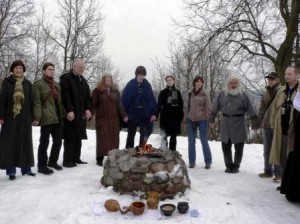Subcultures and New Religious Movements in Russia and East-Central Europe (McKay, Christopher Williams, Michael Goddard, Neil Foxlee, Egidija Ramanauskaite, eds., Oxford: Peter Lang, 2009)

[T]his collection is … useful for at least four reasons. First, it focuses on less known radical groups and movements in relatively unfamiliar locations (Skinheads in Lithuania and Russia, Neo-Pagan Nationalists in Russia, and delinquent and radical groups in Tatarstan), thus allowing for a potentially fruitful comparative approach to the study of radical groups. Second, the volume is focused on the concept of subcultures, the theoretical and methodological value of which is much under-explored in this area of study. Third, its contributions are based on thick ethnography and are good examples of how the appeal and dynamics of radical groups can be better understood through engaging with their participants within their local settings, and taking account of their individual circumstances. Finally, the reader will learn a great deal about the methodologies and logistics of this type of research, including the issues of access and ‘rules of engagement’. Marat Shterin (7 February 2012)
Bulletin Quotidien Europe, European Library no. 10159/874, 2010
Ethnologists, sociologists, philosophers, linguists and other cultural academic specialists provide a passionate insight into the largely unknown and sometimes demonised world of subcultures and new religious movements that have proliferated in Russia and Central and Eastern Europe since the fall of the former Soviet empire…. The first part of the book focuses on the different subcultures which, although they are not an appendage of this part of the world,… are perceived as the product of ‘specifically local post-socialist history’, and in this connection are as different to each other as are the similar cultural movements in the west. This ‘globalization of subcultures in eastern Europe’, according to the formula developed by George McKay and Michael Goddard, is translated, for example, into the Russian skinhead movement of Kazan, the inheritors of the criminal gangs or their Lithuanian alter-egos, also motivated by nationalist ideology. Similarly,… the supporters of the hip-hop movement in Romania and Estonia display both in substance and in style, at least as many differences as points they have in common. [Other contributions in part one] focus on the 1960s counterculture movements, namely the Lithuania hippies, as well as the ‘Euro-Indians’ and an eco-village in Slovakia. Michel Theys (June 15 2010)
2013 Jahrgang 109, Theologische Revue nr. 2
 What impresses in this volume, among other things, is a range of groups focused upon—from hippies and hip-hop musical communities to skinheads, eco-villagers, neo-pagans, theosophy adepts, and Indian-inspired religious movements…. [T]he reader is being immersed into real, dynamic, and vivid material from the ground, providing a useful profile of current youth culture and patterns of distinctive subcultural groupings. The second thing, beyond ethnographies, the authors are aiming at is conceptualization and attempts at theoretical framing….
What impresses in this volume, among other things, is a range of groups focused upon—from hippies and hip-hop musical communities to skinheads, eco-villagers, neo-pagans, theosophy adepts, and Indian-inspired religious movements…. [T]he reader is being immersed into real, dynamic, and vivid material from the ground, providing a useful profile of current youth culture and patterns of distinctive subcultural groupings. The second thing, beyond ethnographies, the authors are aiming at is conceptualization and attempts at theoretical framing….
The conceptualization starts with introductory texts to each of the volume’s two parts. The first one, introducing the theory of subculture, by George McKay and Michael Goddard, is definitely better … [and it] convincingly shows the fundamental change of approaches towards subcultures…. The authors aptly emphasize that this theoretical ‘turn’ was not arbitrary: it depended on shifts in both empirical evidence and social theory.
A very good point of the introduction and the entire volume is taking seriously the socialist period, thus going against short-sighted assumptions of Eastern Europe being a ‘primitive other’ that would readily and easily adopt western social and cultural forms. Alexander Agadjanian, Moskau (164-166)
This book was published with the support of a subvention from EU FP6 funding.


2 replies on “Subcultures and New Religious Movements…”
Thank you Anna, it was a great way to start a new research project, with a pagan ritual! G
That’s a nice photo, loved the landscape.